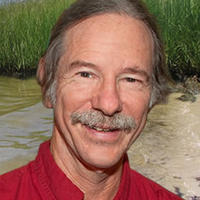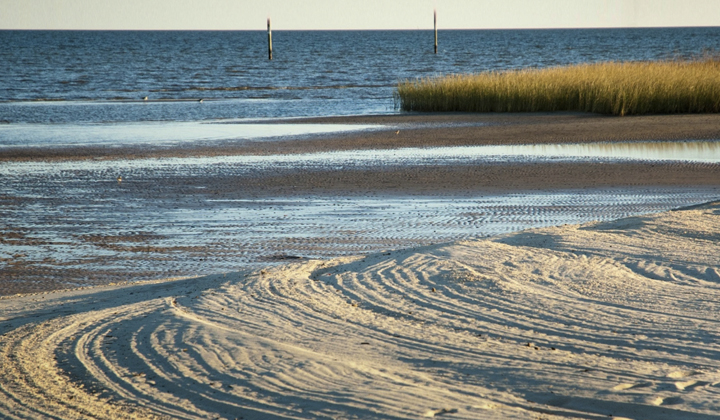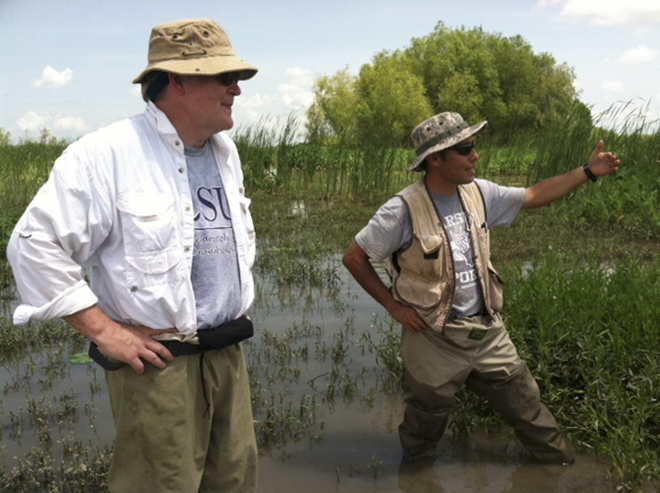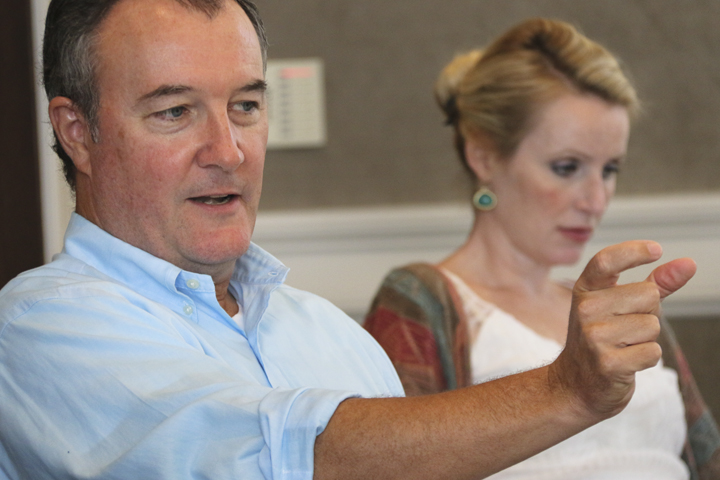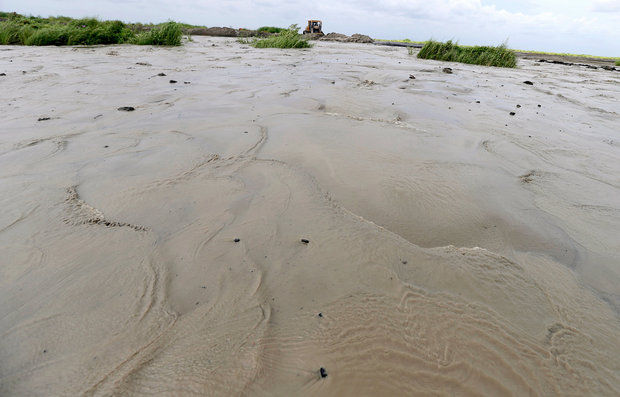Times-Picayune
Black spots in the mix of sediment and water leaving a mile-long pipeline connected to a dredge in the Mississippi River are small chunks of coal. (Photo by Brett Duke, NOLA.com | The Times-Picayune) (Brett Duke, NOLA.com | The Times-Picayune)
By Mark Schleifstein, NOLA.com | The Times-Picayune
on September 02, 2014 at 5:30 PM, updated September 02, 2014 at 5:34 PM
Pieces of coal and petroleum coke – some as large as fists – have been found dotting mile-long stretches of elevated marsh platform created by coastal restoration programs that are pumping sediment inland from the Mississippi River into open water near Lake Hermitage and Bayou Dupont on the west bank of Plaquemines Parish.
The coal and coke debris was spotted at both restoration sites by a reporter and photographer with NOLA.com | The Times-Picayune, including lumps of coal mixed with sediment flowing from the end of a pipeline at the Lake Hermitage restoration project on Aug. 28.
That same day, representatives of the Gulf Restoration Network also found coal and coke debris at the Lake Hermitage site during their own tour of the restoration project. The environmental group filed a complaint about the materials, which it believes is an environmental threat, with the Coast Guard’s National Response Center. The center coordinates pollution responses in federally controlled waters.
The sediment for the Lake Hermitage restoration project is mined at borrow sites along the western edge of the Mississippi’s navigation channel downstream from two terminals that load and unload coal and coke from and to barges and ocean-going vessels. Both terminals, however, are downstream from the Bayou Dupont project.
In his complaint, the Gulf Restoration Network’s Scott Eustis said that in roughly half of a 5-acre area at the Lake Hermitage, the ground was “coated in dice-sized pieces of coal and petroleum coke, at about 25% of the visible surface.” The complaint also said that, “About every meter or so, there was a golf ball sized piece or a baseball sized piece. Softball sized chunks were found.”
“This material contains heavy metals like arsenic and mercury, residual oils and (polycyclic aromatic hydrocarbons), and can make soils acidic,” Eustis said. “While not an emergency, it is entirely inappropriate, in violation of the Clean Water Act, LDEQ permits, and responsible parties are liable for clean up of all spilled material as this discharge is unpermitted.”
A spokesman for the Coast Guard said the coal and coke debris question would be under the jurisdiction of the state Department of Environmental Quality, which enforces federal Clean Water Act and state rules governing emissions from land-based industries that enter the river.
A spokesman for the Army Corps of Engineers, which chairs a task force that oversees federal-state diversion projects, also said DEQ was the agency responsible for regulating the coal debris.
DEQ did not immediately respond to a request for information about the contaminants found in the restoration sites.
The state Coastal Protection and Restoration Authority, which participates in both the Lake Hermitage and Bayou Dupont restoration projects and is the sponsor of the Bayou Dupont long distance pipeline project, discounted the potential for environmental effects from the coal and coke, but said it needs further study.
Some coal lumps found at the Lake Hermitage project were the size of softballs.
Gulf Restoration Network
“CPRA has not observed any negative environmental effects on our projects that have been restored with Mississippi River sediment; however, this is an area that warrants further analysis,” said a statement released by the agency. “The future of our coast is dependent on the efficient and effective use of our riverine resources, which is evident in the 25,704 acres of wetlands benefited by our work since 2008. CPRA is committed to understanding the environmental effects of our projects.”
The Lake Hermitage project will have 653 acres of new marsh platform when it is completed, with all but 104 acres paid for by the federal-state Coastal Wetlands Planning, Protection and Restoration Act. The additional acreage is being paid with an advance payment by BP under the federal Oil Pollution Act’s Natural Resource Damage Assessment program.
The Bayou Dupont marsh creation project near Ironton also began as a Coastal Wetlands Act project and built 471 acres of new marsh platform. State officials plan to extend the marsh platform westward with a state-funded long distance pipeline that will eventually extend more than 25 miles across Plaquemines, Jefferson and Lafourche parishes.
One of the coal and coke transfer terminals located upriver from the site mined for the Lake Hermitage project is United Bulk Terminal-Davant, which recently entered into a consent agreement with DEQ. The agreement was part of the settlement of a January penalty notice for illegally dumping coal and coke on the east bank Mississippi River batture at United Bulk’s storage yard less than a mile upriver from the dredging borrow area.
Company officials told state inspectors that when the river rose above the debris on the batture, it wasn’t retrieved.
The state inspected the facility in June 2013 and reviewed company records in December 2013 and concluded that the firm had failed to dispose of spilled coal and coke immediately, according to the consent agreement.
“Specifically, at the downstream end of the facility, coke and coal fall from the conveyer belts onto the batture,” says the consent agreement.
“According to the facility representative, the cleanup occurs as long as the river is low,” the consent agreement said. “When the river is high, the piles of coal and coke are submerged in water and cleanup does not occur. At the time of the inspection, the river was high. Each failure to utilize all reasonable methods to minimize any adverse impact, and clean up and dispose of all spilled product and spilled waste immediately is a violation …”
As part of the consent agreement, United Bulk has agreed to donate $16,500 to the Woodlands Conservancy, which operates the Woodlands Trail and Bird Park Sanctuary in Plaquemines. The conservancy will use the money to remove invasive species from its land and replace them with native species.
The company also has agreed to raise 3 ? acres of the batture area beneath its conveyer belts “to enhance the removal of coal/coke that may fall from the conveyer belts to the batture area in order to enhance compliance with existing permits during times of high water,” according to an Army Corps of engineers coastal use permit request filed with the consent agreement.
The firm also has agreed to improvements to its conveyer system aimed at reducing spillage that are part of an $80 million upgrade of the terminal.
“Since United Bulk Terminals Davant acquired the facility in June of 2012, we have demonstrated our commitment to minimizing the impact of our operations on the environment and have invested substantial time and money to ensure compliance with our air and water permits,” the firm said in a statement issued in response to questions about the coal and coke found last week in the restoration projects.
The statement said the firm has invested nearly $50 million to upgrade its facility “in accordance with the latest technology and practices in terms of safety and environmental impact,” and plans to invest another $30 million. The improvements included spill pans for secondary containment under the conveyers, the statement said. The agreement with DEQ also includes modifications to the batture to prevent spillage regardless of the river stage, the company said.
The DEQ complaint was filed two months after the Gulf Restoration Network, Louisiana Environmental Action Network and Sierra Club informed United Bulk that they planned to file a complaint in federal court against the company under provisions of the Clean Water Act that allow citizens to attempt to enforce the law.
The groups filed suit against the firm in March, even though the company had already indicated it would agree to a preliminary version of the state consent decree. The suit said that based on DEQ’s past track record, it wanted to assure that the company complied with all provisions of the federal clean water law.
That lawsuit is still pending.
On the east bank of the river, International Marine Terminals operates a similar coal loading facility just below Myrtle Grove, with conveyer belts that also extend out over the river.
A check of DEQ records indicates that company has reported inadvertent spills of coal into the river, including one spill of as much as 3,000 pounds in 2010. But there’s no record of any enforcement actions by DEQ for such spills.
